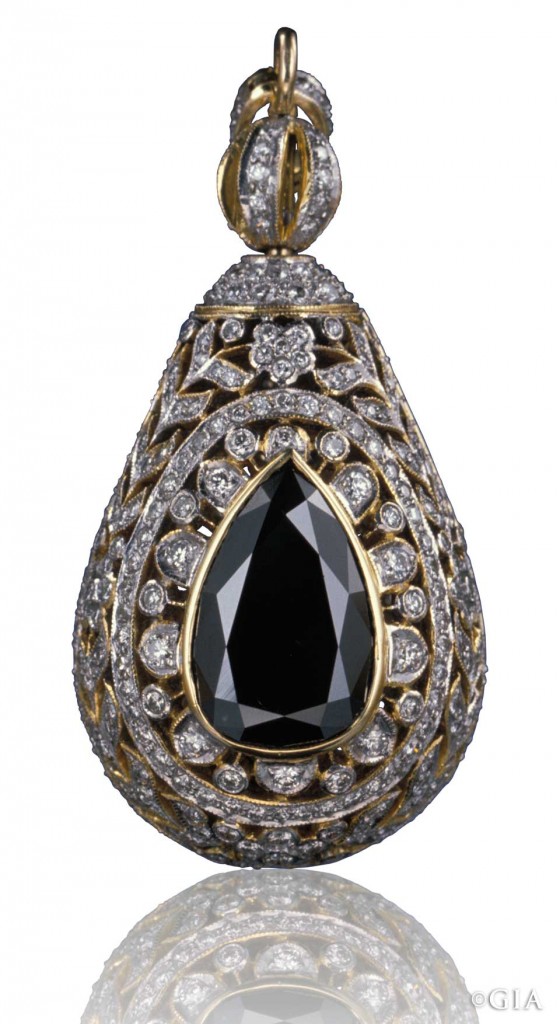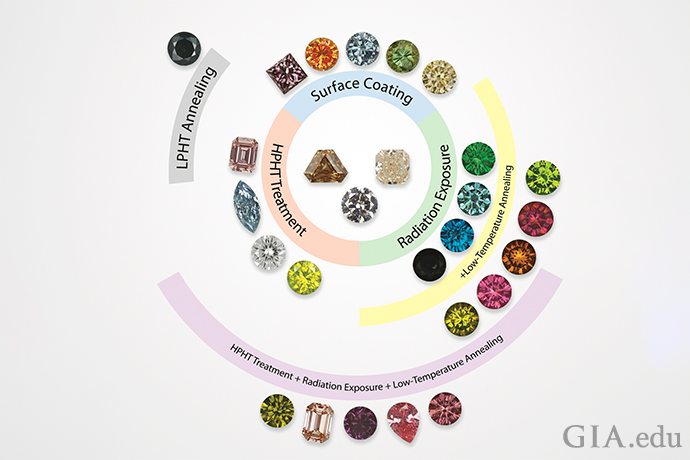If you’re thinking of buying a colored diamond, you’ll want to know if its color is natural or is the result of a treatment process.
Humans have been treating diamonds to enhance their appearance for centuries. There is nothing inherently wrong with treating diamonds to change their color– as long as the treatment and any special care requirements are disclosed. The trouble arises when treatments are not disclosed, because in such cases, you think you are purchasing one thing but are really buying something else. Since diamonds are expensive and often emotionally symbolic, buying a misrepresented one is no small matter.
The 104.53 ct Deepdene is one of the most notorious examples of a famous treated diamond – and what happens when the truth is discovered. In the mid-1950s, the Deepdene was irradiated and then heated to intensify its yellow hue. However, this information was not provided to Christie’s auction house when it was consigned and sold in 1971. GIA confirmed that indeed, it was treated and the sale was rescinded. The treater eventually came forward and confirmed that the stone was treated.
A number of processes can be used to change the color of a diamond. Here are some of the more common treatment methods:
- Paints and coatings:
In the 1568 treatise of Benvenuto Cellini, the Italian goldsmith and sculptor boasted how he could enhance the color of yellow diamonds by using indigo, a blue dye. Modern advanced variations employ thin film coatings to create diamonds of all colors. Low-tech variations include nail polish and permanent markers.
- Irradiation and heat:
Scientists began irradiating diamonds over a century ago; their early experiments produced radioactive gemstones and color changes that were confined to thin zones near the surface. Neutron irradiation in a reactor and high-energy electron irradiation in a particle accelerator are now the most common treatment methods. Heating irradiated diamonds to above 500o C will change most blue-to-green colors to brownish or orangy yellow to yellow, or, in rare cases, pink to red. - High-pressure high-temperature (HPHT) annealing:
Exposing diamonds to very high pressures and temperatures can lighten the color of some brownish diamonds. In some instances, it can also be used to create certain fancy colors. It is the most common treatment method used to create treated yellow diamonds.
- Low-Pressure, High-Temperature Annealing:
Heat treatment under low pressures can be used to create black diamonds by causing graphite to form in surface reaching fractures. The process is so commonplace, that black diamonds treated this way are more prevalent that natural color black diamonds.

The approximately 5.75ct “black” diamond in the pendant is a slightly radioactive laboratory-irradiated very dark green diamond. Photo Shane F. McClure/GIA.
Shown below examples of the wide range of treated-color diamonds now available on the market. Colors across the entire visible spectrum are now achievable with the proper starting material and combination of treatments.
The three diamonds at the center of the diagram are the less-valuable starting colors that are most often used for color treatment processes. In addition, this diagram groups colors by the treatment methods.
Detecting diamond color treatments often requires sophisticated testing and instrumentation, the kind you find only in the best equipped laboratories like the GIA Laboratory. Whether a diamond’s color is natural or artificially induced can almost always be determined. In rare cases, such as with some green diamonds, existing gem identification techniques and testing equipment cannot positively determine the source of color and the GIA Lab will note the color origin as undetermined.

All of these colored diamonds (0.12-1.38 ct) were treated by irradiation and, except for the black, blue and green stones, subsequent heat treatment. Photo by Robert Weldon/GIA.
A GIA Colored Diamond Grading Report or Identification and Origin Report will tell you if the color in the diamond you’re eyeing is natural or treated, helping you make the purchase with total peace of mind.






